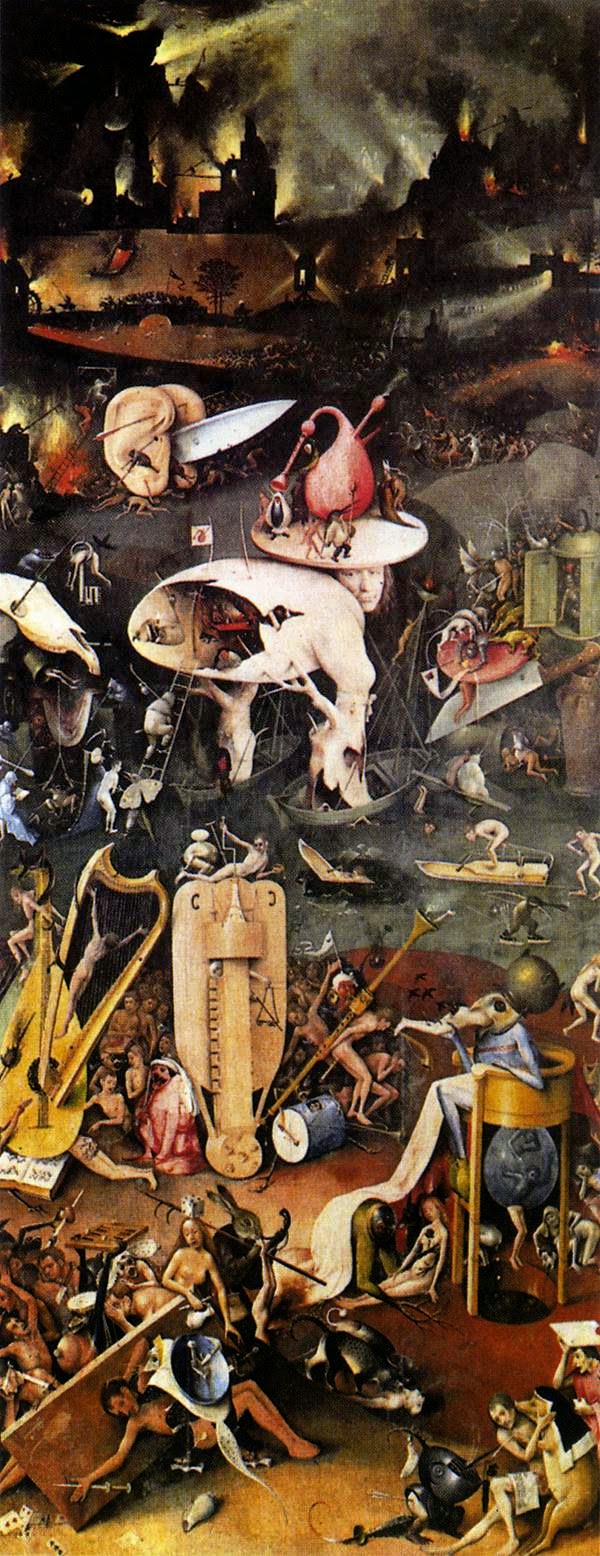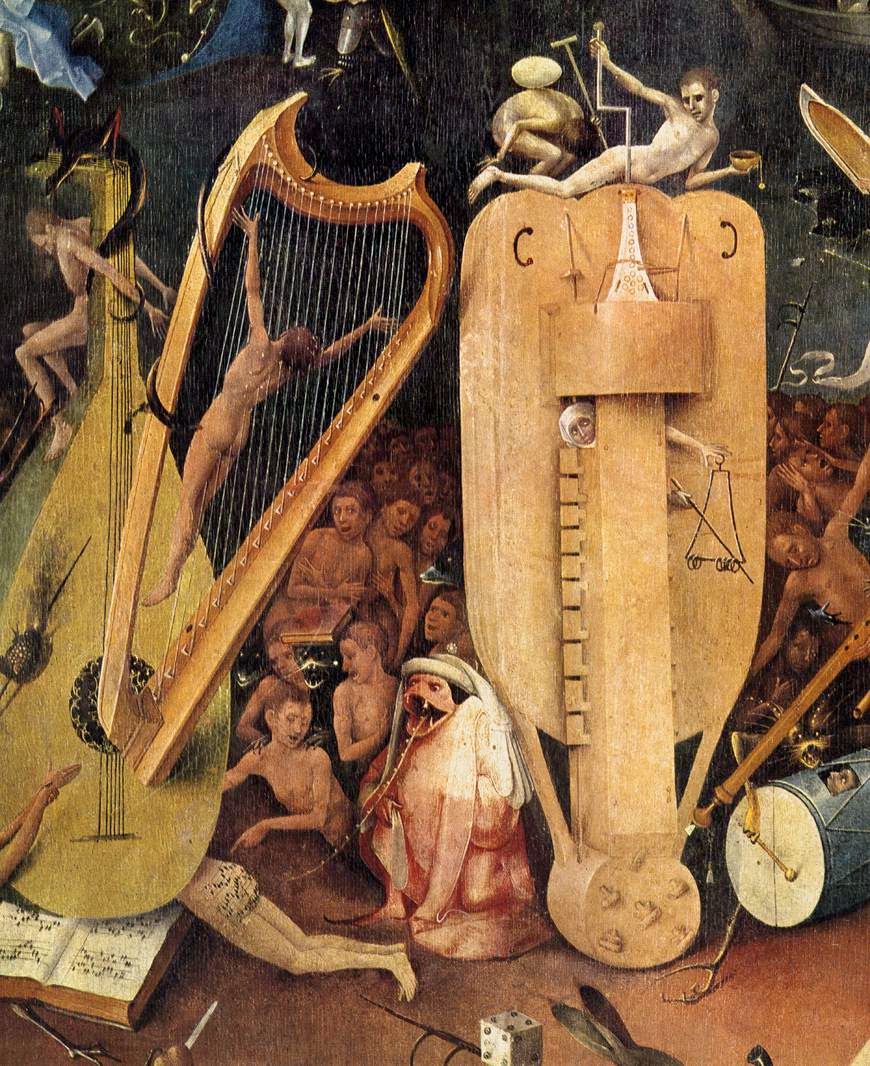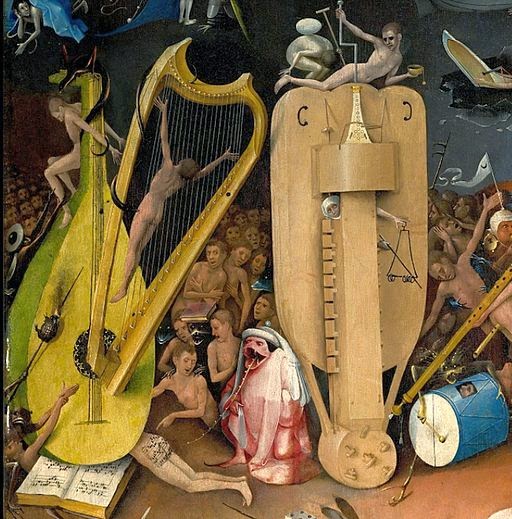None of this could
have been foreseen by Bosch: the haunting refrain of the
600 year old butt song from Hell
Is it difficult to conceive that the group of damned souls
in the right wing of Bosch’s Triptych which represents the Musicians' Level would
sing a hymn from the musical score fixed to the reverse of the reclining figure
in front of the ensemble, led by an infernal monster? It could more likely be a parody.
Dutch master Hieronymus Bosch’s paintings are packed full of vivid imagery and complex meanings.
By
far the best known and most ambitious work, The Garden of Earthly Delights
illustrates Bosch’s individual artistic style, containing the most vivid
imagery and complexity of symbolic meaning.
Bosch painted his three part masterpiece
between 1490 and 1510 when he was around 50 years old.
The open triptych shows three scenes. The left
panel is dedicated to Paradise, with the creation of Eve and the fountain of
life, while the right panel shows hell. The central panel gives its name to the
entire piece, representing a garden of life’s delights or pleasures. Between
paradise and hell, these delights are nothing more than allusions to sin,
showing humankind dedicated to diverse worldly pleasures. There are clear and
strongly erotic representations of lust, along with others, whose meanings are
more enigmatic. The fleeting beauty of flowers and the sweetness of fruit
transmit a message of fragility and the ephemeral character of happiness and
enjoyment. This seems to be corroborated by certain groups, such as the couple
enclosed in a crystal ball on the left, which probably alludes to the popular
Flemish saying: “happiness is like glass, it soon breaks”.
 |
| BOSCH, Hieronymus Triptych of Garden of Earthly Delights |
The
triptych is generally thought to be a warning of the dangers of giving in to
temptation, but has been subject to vast amounts of conjecture and scrutiny,
and critics and historians are split in two directions. Whereas some believe
that the middle panel, which depicts a fantastical world of nudes in sexual
engagement, large fruits, and other suggestive elements, is simply an
illustration of paradise lost, others believe that it is a moral warning, which
will lead you to hell, as it is depicted in the third panel of the series. Although
there are many contradictory explanations, it is generally thought to be a
warning against lust, one of the seven deadly sins.
 |
| Right Panel. Sheet music in question located in top left corner: 1480-1505. Museo del Prado, Madrid, Spain. |
Several huge musical instruments figure prominently in Bosch's conception of hell. They are shaped similarly to the ones used at that time, but their positioning is unrealistic (for example, a harp grows out of a lute). Their relationship to each other bears strongly fanciful elements, and they have been adapted in form. What is more, the use of these instruments is wholly fantastic. There is a human figure stretched across the strings of a harp; another writhes around the neck of a flute, intertwined with a snake; a third peers out of a drum equipped with bird-like feet, the next one plays triangle while reaching out from a hurdy-gurdy, and even the smoking trumpet displays an outstretched human arm. It is difficult to conceive that the group of damned souls would sing a hymn from the musical score fixed to the reverse of the reclining figure in front of them - although this has been proposed by some scholars. The ensemble, led by an infernal monster, could more likely be a parody.
.jpg) |
| Triptych of Garden of Earthly Delights (detail) |
The scene is set at night, and the natural beauty that adorned the earlier panels is absent. Cities are aflame; there are torture chambers, demons and mutated animals feeding on mangled humans.
Writer Walter S. Gibson said that explosions in the background are ‘turning the water below into blood’. The foreground is populated by a variety of distressed or tortured figures. Some are crucified by harps and lutes to sharpen the contrast between pleasure and torture.
The ‘tree man’ has three naked people in his hollow torso and the image is thought to suggest sexuality and lust, which in the Middle Ages were seen by some as humanity’s fall from grace and the deadliest of sins.
 |
| Bosch_Hieronymus_-_the_garden_of_earthly_delights_right_panel_-_detail_musical_instruments_left |
Not one person had tried to play a tiny piece of music tattooed on the bottom of a man languishing in hell (pictured in the top left hand corner) in the triptych painting until now - 500 years after the work was created.
An enterprising blogger has recorded a piece of music hidden in Hieronymus Bosch’s painting The Garden of Earthly Delights, bringing to life a series of notes that originally appeared on the backside of one of Bosch’s sinners.
Posting onher Tumblr, a self-described “huge nerd” called Amelia explained that she and a friend had been examining a copy of Bosch’s famous triptych, which was painted around the year 1500. “[We] discovered, much to our amusement,” she wrote. “[a] 600-years-old butt song from Hell.”
Once zoomed-in, the object of Amelia’s interest is clear: Bosch left sheet music “written upon the posterior of one of the many tortured denizens of the rightmost panel of the painting”.
“I decided to transcribe it into modern notation,” Amelia explained, “assuming the second line of the staff is C, as is common for chants of this era ... The last few measures are kind of obscured but i tried my best.”
The rest is history, really. Amelia posted a piano version of the torture-victim’s backside hymnal. Someone else wrote some silly lyrics (key phrase: “we sing from our asses while burning in purgatory”) and arranged it as choral chant. Soon, each post had received thousands of notes and reposts.
None of this could have been foreseen by Bosch, for whom The Garden Of Earthly Delights was probably a caution against the unending hazards of sin. While music and musical instruments are major motifs of his masterwork, which has long been on display in Madrid, these are often interpreted as symbols of pleasure, lust or the notoriously naughty habits of traveling minstrels.
The Choral Version of 600 years sinners' hymn in Hieronymus Bosch's The Garden of Earthly Delights
Sources:
wikiart.org,
wga.hu
wga.hu
Museo Nacional del Prado,
theguardian, dailymail
theguardian, dailymail


No comments:
Post a Comment